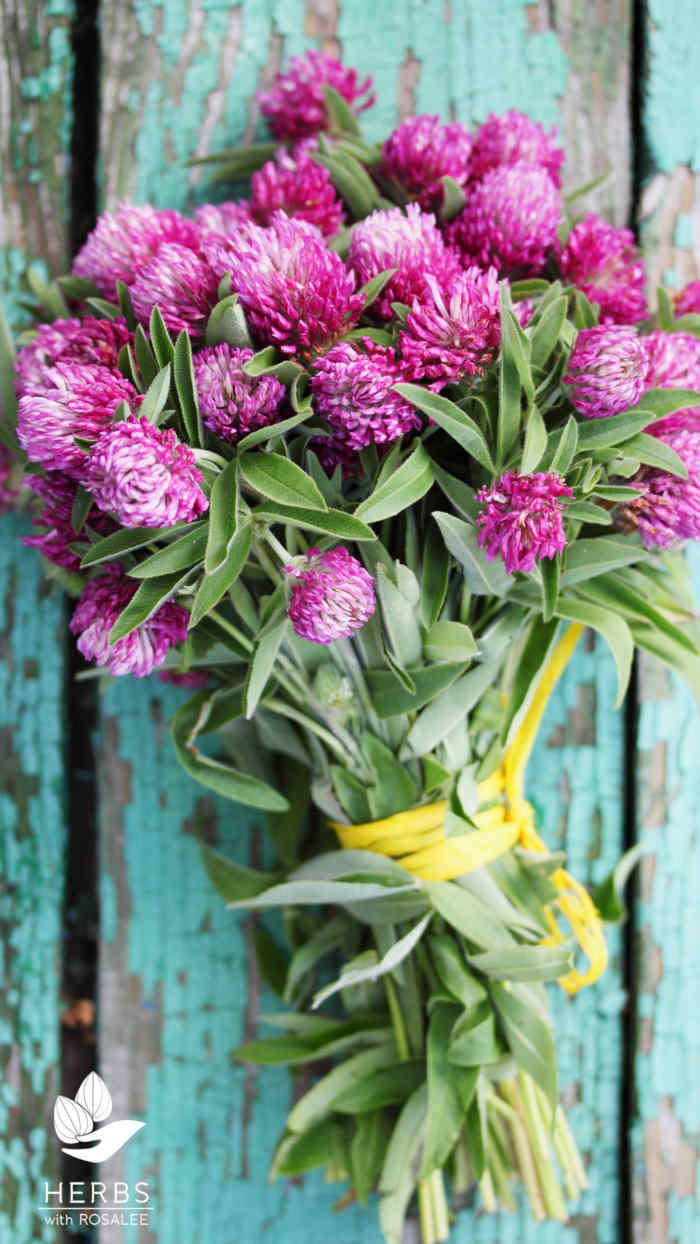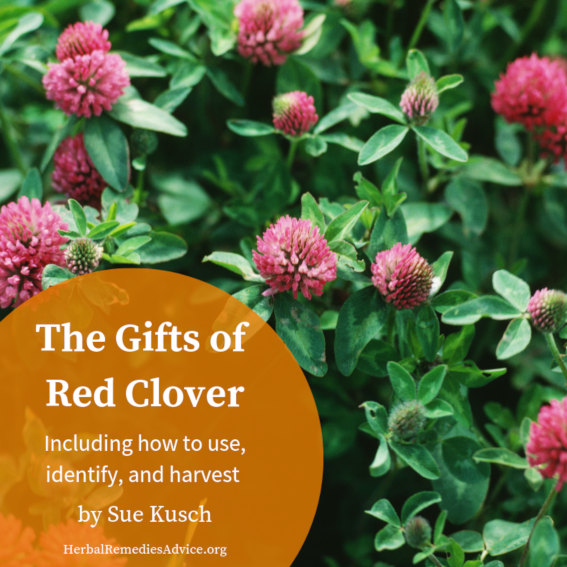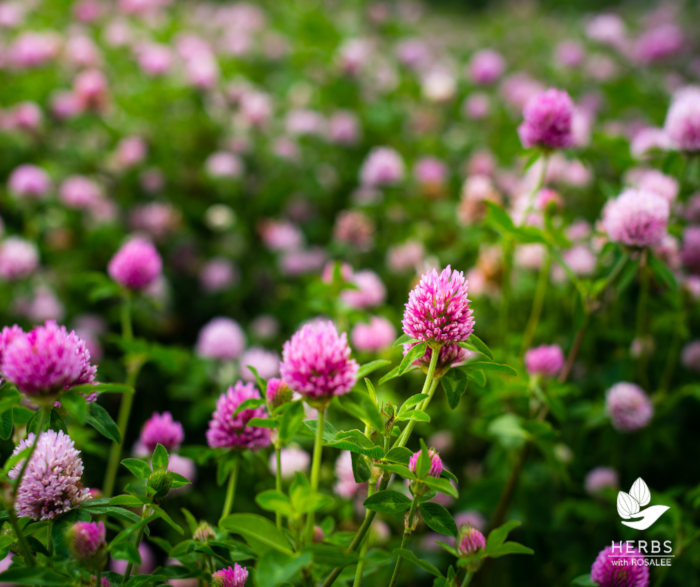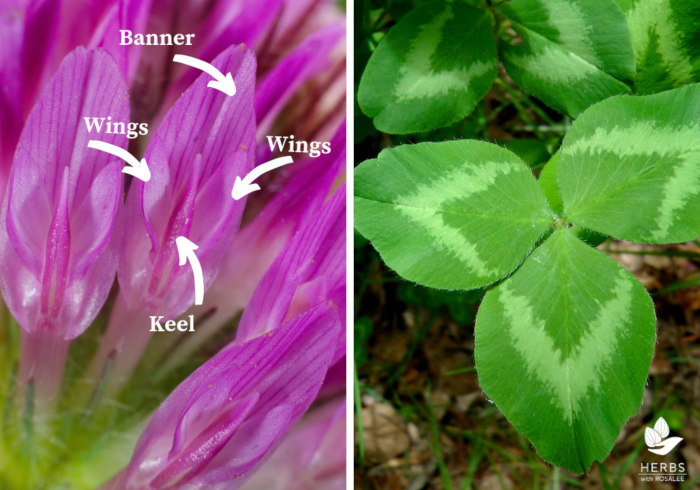Get weekly tips, recipes, and my Herbal Jumpstart e-course! Sign up for free today.

Red Clover Uses
Share this! |
|
During the months of spring and summer, my daily fitness walks along my rural graveled road turn into slow-moving plant hunting sessions. My dog, Murphy, welcomes the slower pace, sniffing and marking his territory along our route. With pruners in hand, I fill my gathering basket and paper bags with the blooms of early summer: elderberry, yarrow, St. John’s wort, and red clover.
My neighbors no longer stop to ask what I am doing; they smile and wave as they drive by. Over the years, several of them have come to appreciate, even rely on, my annual Solstice gift of elderberry medicine. But their faith in the power of plants has its limits, and my attempts to share the benefits of other plants are politely listened to but, I suspect, go mostly unheard.
On a recent group walk with them, I pointed to this year’s red clover blossoms along the road, casually remarking how the heavier-than-usual spring rains and cool temps have made for abundant and long-lasting blooms. They were surprised to learn that I harvested them and asked what I did with them. Energized by their interest, I jumped right in with red clover uses and its many benefits before their interest levels declined!
Red Clover Uses: A Plant with Multiple Gifts
Red clover uses (Trifolium pratense) include a diversity of gifts: forage for livestock, a nitrogen-fixing green manure for soil, and food and medicine for humans. Native to southeastern Europe, Africa, and Central Asia, it was introduced to North America by the early English colonists for livestock grazing. Adaptable to a variety of climates and tolerant of a range of soil conditions, it became naturalized throughout North America, escaping the fields for rural ditches, roadsides, and lawns. (The species name, “pratense”, means of the meadow.) Because of its past extensive use in agriculture, there are numerous cultivars available that were developed to suit the specific needs of farmers.
Red clover is valued by a variety of wildlife species: songbirds, quail, grouse, wild turkey, marmot, woodchuck, squirrels, mice, and deer will eat different parts of the plant. In the Southern states of the USA, red clover is planted in food plots by game managers and hunters to ensure quality habitat and forage for whitetail deer. Attractive to beneficial insects (who eat the pests eating your crops), bumblebees are one of the main pollinators of red clover blooms while honeybees prefer the sweeter white clover, producing the widespread and popular clover honey.1
Red Clover Uses: An Ideal Green Manure
Organic growers recognize that soil is the foundation of healthy plant life and annually shovel aged animal manure and compost into their growing beds to develop a vibrant soil alive with microorganisms. Planting green manures is another strategy to build up biomass (organic matter) in soils. Planting legumes like clovers that fix nitrogen from the air offer an additional benefit of extra nitrogen for future plant growth.
For an herbalist who also grows vegetables and fruits, red clover offers a win-win solution: sown in the early spring or previous fall, the herbalist can harvest the blooms in mid-summer for food and medicine, then dig in (never till) the plant into the soil so it can decompose and add both biomass and nitrogen to the soil. Before commercial synthetic fertilizers became available, planting clover as a green manure was a highly regarded technique for improving both the soil and its nutrient levels.
Red Clover Uses as a Food
One of the reasons that red clover is a popular forage for animals is because it offers a high level of nutrition, and it can serve the human diet for the same reasons. Red clover is packed with nutrients and minerals (sadly, a common deficiency in our soils and vegetables). All parts of the plant are safe to eat but the flowers are the most commonly foraged and are used fresh in salads and as a wild snack. Red clover's brightly colored flowers contain many nutrients, including calcium, chromium, magnesium, niacin, phosphorus, potassium, thiamine, and vitamin C.
In Katrina Blair’s book, The Wild Wisdom of Weeds, she provides several recipes for using clover flowers to make cookies, crackers, a raw casserole, apple pie, tomato bisque, and a sun tea.2
Red Clover Uses: Identification
A member of the Fabaceae (legume) family, Trifolium means three leaves and the genus consists of at least 245 species worldwide. Its size ranges from 18-30 inches tall, with multiple stems. It grows a long and branched taproot, which allows the plant to sustain itself during drought. Red clover hosts multiple hollow and hairy stems and branches that grow a bit leggy. The leaves are leaflets of three and have a distinctive feature that knitters will recognize as a chevron: a whitish V-shaped spot on each green leaflet.
The flowers of red clover are actually a cluster of many individual tiny flowers with five inconsistently shaped petals, following the classic legume floral structure: two upper petals form the keel, two bottom petals form the wings and the largest petal is called the banner. Their color ranges from a light pink to a reddish purple.
Though it is often identified as a short-lived perennial, the climate and the grower’s intended purpose (e.g., forage, cover crop, food/medicine) often determine its life cycle. It can grow in USDA Hardiness Zones 4 and above but prefers the cooler summers of the north. When cultivated for forage or green manure, it is usually treated as a biennial, meaning that it is killed and dug into the soil while in mid-bloom in the spring of its second year.3
Red Clover Uses: Harvest
Like all herbs, careful attention should be paid to the quality of the blossom when harvesting. Flowers can begin to brown within a day or two of fully blossoming and should not be picked at that point. Avoid taking all of the flowers from one plant; spread your wildcrafting far and wide. Unless, of course, you have cultivated them in your garden.
Careful drying is critical as mold can easily grow on clover flowers. I follow most of the advice (I store dried blossoms in glass jars) of well-known American herbalist Jethro Kloss who offered this on red clover blossoms from his classic herbal remedy book, Back to Eden:
Red clover is one of God’s greatest blessings to man...Every family should have a good supply of red clover blossoms. Gather them in the summer when in full bloom. Dry in the shade on papers. Put in paper bags when dry and hang in a dry place. Use this tea in place of tea and coffee and you will have splendid results. Use it freely. It can be taken in place of water.4
Red Clover Uses: Nourishing Herbal Infusions
I harvest red clover blossoms and dry them for year-round use in my weekly nourishing infusion blend that includes other nutrient and mineral-rich herbs. Years ago, when I began to explore herbs as more than seasonings and teas, I first discovered the concept of nourishing infusions through herbalist Susun Weed. In those days, I was busy with a full-time job, caring for my family, managing a home and, to be honest, nutritious meals didn’t always magically appear on the dining table. As I learned more about the critical role that nutrients and minerals play in the overall health of my aging body, I began to incorporate some simple strategies to increase my intake of healthy plant foods. One of the easiest to do, nourishing herbal infusions introduced the notion that herbs could offer more than taste and the occasional remedy; they could be part of my daily wellness plan to support my body’s need for healthy doses of nutrients and minerals.
Drinking herbal infusions solved another issue for me: I was aware that I needed to increase my daily intake of water (I would often work for 2-3 hours without rehydrating) so drinking herbal infusions was an easy way to both hydrate and nourish my body throughout the day. The need to increase my mineral intake was also a primary motivator: I was approaching menopause and was aware of the importance of maintaining strong bones after menopause. Bone health is an important issue for post-menopausal women. Estrogen is essential for bone health, ensuring that calcium is absorbed into the bones. Estrogen declines after menopause and bones can quickly become porous, putting older women at a higher risk for hip fractures and bone breaks. The best way to supply our bodies with more minerals like calcium is to eat and drink them.
My first infusion was nettle and well,... it did not go down very well! But I was committed to this easy and inexpensive method for improving my nutrient intake so I did more research on mineral-rich herbs and red clover was recommended. After much experimentation, I now make a half gallon of this simple nourishing infusion recipe each week. I drink at least two cups a day and drink more if I did not eat any leafy greens that day. I prefer it cold and keep the strained infusion in my refrigerator for no longer than 48 hours to avoid spoiling.
Note: Though I choose to combine herbs to make a blend, the original recommendation is to infuse and drink one herb at a time. If not familiar with the individual taste and effects of these herbs, I suggest you infuse and drink them separately.
Red Clover Uses: Nourishing Infusion Recipe

In a half gallon canning jar I blend two ounces of the following dried herbs (do not use fresh herbs):
I generally use handfuls rather than exact measurements and aim for equal amounts of each herb. Sometimes I am out of one of the herbs so I increase the amounts of others to ensure I have 2 ounces. To help with the taste, I sometimes add a bit of lemon balm or spearmint. Last year, a friend gave me a large bag of stevia, and I have been adding a couple of large pinches but avoid adding more than that. Stevia is a potent sweetener.
I add just-boiled water to fill the jar, put the lid on tightly and let it sit overnight (8 hours). In the morning, I strain the herbs out and store it in the refrigerator. I have also added it to soups and to my dog’s dry food.
I am not going to lie to you: initially, I did not enjoy the taste of nourishing infusions. But after a few weeks of regularly drinking this blend, I now crave it. Don’t be afraid to experiment with other herbs like raspberry leaves, hawthorn leaves & berries, rose hips, and linden.
Red Clover Uses Citations
1. Plants Profile for Trifolium Pratense (red Clover). Accessed July 14, 2019. https://plants.usda.gov/core/profile?symbol=TRPR2.
2. Blair, Katrina. The Wild Wisdom of Weeds: 13 Essential Plants for Human Survival. White River Junction, VT: Chelsea Green Publishing, 2014.
3. Nationwide, SARE. "Red Clover." SARE. Accessed July 14, 2019. https://www.sare.org/Learning-Center/Books/Managing-Cover-Crops-Profitably-3rd-Edition/Text-Version/Legume-Cover-Crops/Red-Clover.
4. Kloss, Jethro. Back to Eden: The Classic Guide to Herbal Medicine Natural Foods and Home Remedies. Santa Barbara, CA.: Woodbridge Press, 1975.

Sue Kusch, a former community college instructor and academic advisor, incorporates her experiential wisdom, expertise and science-based research garnered from her three decades of growing vegetables, fruit and herbs into her educational writing about plants and how people use them. In addition to her BA in Social Sciences and Masters in Education, she completed the Master Gardener training in 2011 and two permaculture courses in 2001 and 2014. She has studied medicinal and nutritional uses of herbs, including studies at Herbmentor and East West School of Planetary Herbology, since 1997. An avid reader, lover of historical and folkloric information, and a promising storyteller, Sue writes about the intersection of plants and people.


